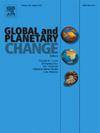PlanetScope图像和深度学习揭示了兴都库什-喜马拉雅山脉冰川上池塘的短期动态对比
IF 4
1区 地球科学
Q1 GEOGRAPHY, PHYSICAL
引用次数: 0
摘要
在过去的几十年里,在兴都库什-喜马拉雅山脉(HKH)的冰川表面上形成和扩展了越来越多的冰川上池塘。尽管在年和年代际尺度上观测到明显的时空变异,但在大空间尺度上对其季节变化的研究是有限的。这些研究对于评估冰川消融和动态的影响以及预测水资源的可用性至关重要。在这里,我们使用一种应用于PlanetScope图像的基于深度学习的制图方法,制作了2017年至2022年HKH五个地点的冰川上池塘的详细季节性地图。利用这些图,我们研究了池塘的季节性和年际变化。结果表明:(1)中喜马拉雅地区(417个,1.55%)和东喜马拉雅地区(481个,1.93%)的平均池塘数量和池塘面积占碎屑覆盖面积的比例高于兴都库什山脉(142个,0.20%)和西喜马拉雅地区(153个,0.19%);(2) 2017 - 2020年喀喇昆仑地区(+0.2%)、喜马拉雅中部地区(+0.6%)和喜马拉雅东部地区(+0.9%)的池塘面积比碎屑覆盖面积增加;(3)喀喇昆仑山和兴都库什山脉的冰川上池在消融季节(5 - 6月)开始时、喜马拉雅西部和中部的季风前季节、喜马拉雅东部的季风期和季风后季节达到峰值;(4)喜马拉雅中部地区持久性池塘的发生率最高(17.2%),喀喇昆仑地区持久性池塘的发生率仅为4.3%。我们的研究结果提供了一个空间多样性和时间详细的数据集,有助于促进对兴都库什-喜马拉雅地区冰川上池塘动态的理解。本文章由计算机程序翻译,如有差异,请以英文原文为准。
Contrasting short-term dynamics of supraglacial ponds along the Hindu Kush-Himalaya revealed by PlanetScope imagery and deep learning
An increasing number of supraglacial ponds have formed and expanded on the surface of debris-covered glaciers across the Hindu Kush-Himalaya (HKH) mountain range in the last decades. Despite the pronounced spatio-temporal variability observed in supraglacial ponds at annual and decadal scales, investigations of their seasonal changes are limited over large spatial scales. These investigations are critical for evaluating their impacts on glacier ablation and dynamics and predicting water resource availability. Here, we produced detailed seasonal maps of supraglacial ponds at five sites of the HKH for the years 2017 to 2022 using a deep-learning-based mapping method applied to PlanetScope imagery. Using these maps, we investigate pond seasonality and interannual variability. We found that (1) the average pond number and percentage ponded area over the debris-cover area were higher in the Central Himalaya (417, 1.55%) and Eastern Himalaya (481, 1.93%) compared to those in the Hindu Kush (142, 0.20%) and Western Himalaya (153, 0.19%); (2) pond percentage area over debris-cover area showed an increase in the Karakoram (+0.2% in an absolute sense), Central Himalaya (+0.6%) between 2017 and 2020, and Eastern Himalaya (+0.9%) between 2018 to 2021; (3) supraglacial ponds reached their peak at the onset of the ablation season (May-June) in the Karakoram and the Hindu Kush, during the pre-monsoon season in the Western and Central Himalaya, and during the monsoon or post-monsoon period in the Eastern Himalaya; (4) the Central Himalaya displayed a highest occurrence of persistent ponds (17.2%), while only 4.3% of supraglacial ponds in the Karakoram were persistent. Our results provide a spatially diverse and temporally detailed dataset that serves to advance the understanding of supraglacial pond dynamics across the Hindu Kush-Himalaya.
求助全文
通过发布文献求助,成功后即可免费获取论文全文。
去求助
来源期刊

Global and Planetary Change
地学天文-地球科学综合
CiteScore
7.40
自引率
10.30%
发文量
226
审稿时长
63 days
期刊介绍:
The objective of the journal Global and Planetary Change is to provide a multi-disciplinary overview of the processes taking place in the Earth System and involved in planetary change over time. The journal focuses on records of the past and current state of the earth system, and future scenarios , and their link to global environmental change. Regional or process-oriented studies are welcome if they discuss global implications. Topics include, but are not limited to, changes in the dynamics and composition of the atmosphere, oceans and cryosphere, as well as climate change, sea level variation, observations/modelling of Earth processes from deep to (near-)surface and their coupling, global ecology, biogeography and the resilience/thresholds in ecosystems.
Key criteria for the consideration of manuscripts are (a) the relevance for the global scientific community and/or (b) the wider implications for global scale problems, preferably combined with (c) having a significance beyond a single discipline. A clear focus on key processes associated with planetary scale change is strongly encouraged.
Manuscripts can be submitted as either research contributions or as a review article. Every effort should be made towards the presentation of research outcomes in an understandable way for a broad readership.
 求助内容:
求助内容: 应助结果提醒方式:
应助结果提醒方式:


